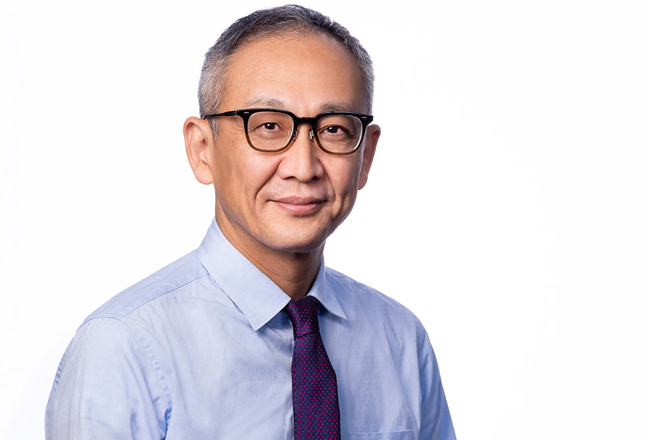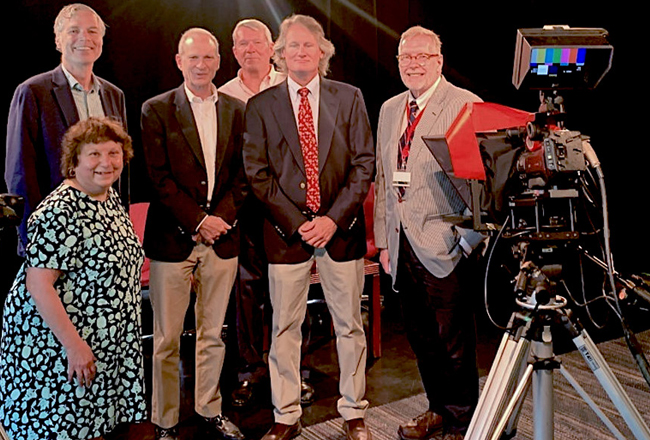 One of the region”™s most prominent international companies is Japan”™s Fujifilm Holdings Corp., which has its U.S. operations based in Valhalla. In this edition of Suite Talk, Business Journal Senior Enterprise Editor Phil Hall speaks with Tetsuya Iwasaki, president of Fujifilm Holdings America Corp. and president and CEO of Fujifilm North America Corp., on how the company weathered the Covid-19 pandemic and how it participates within the Westchester business environment.
One of the region”™s most prominent international companies is Japan”™s Fujifilm Holdings Corp., which has its U.S. operations based in Valhalla. In this edition of Suite Talk, Business Journal Senior Enterprise Editor Phil Hall speaks with Tetsuya Iwasaki, president of Fujifilm Holdings America Corp. and president and CEO of Fujifilm North America Corp., on how the company weathered the Covid-19 pandemic and how it participates within the Westchester business environment.
How has the company fared during the Covid-19 pandemic? Specifically, were there challenges to keeping the workforce in place and staying focused on research and development projects amid the health crisis?
“Fujifilm Holdings America Corp. formed a public health response committee early on ”” in January 2020 when the first Centers for Disease Control and Prevention (CDC) bulletins came out about the virus. The committee was instrumental right from the start in keeping the health and safety top-of-mind for all of our employees across North America.
“For the first few months of the pandemic, the committee met daily (sometimes multiple times a day) to make real-time decisions about how to support and protect our workforce and continue to serve our customers.
“The membership of the public health response committee was intentionally broad and it included function leaders representing all major departments, including legal, compliance, facilities, environment, health and safety, human resources, finance, information technology and corporate communications, as well as representation from the business function.
“We adapted our business practices in order to safeguard our staff, as well as to continue to serve our customers, many of whom impower critical operations in the fields of health care, technology and media.
“As a global technology company, we had the infrastructure in place to continue to serve our customers and meet virtually with colleagues. We enacted a work-from-home policy for all workers that could complete their job remotely.
“For essential workers who continued to report to work on-site, we implemented social distancing and split shifts, enhanced cleaning procedures at our sites, encouraged workers to follow good hygiene practices based on the CDC guidelines, and restricted travel, meetings, events and visitors.
“We are grateful to the many employees whose functions were essential to the operations of some of our businesses and continued to come to the workplace every day throughout the pandemic ”” with precautions in place to protect them while on-site.
“Throughout all of this, Fujifilm remained committed to leveraging our resources, talent and technologies to support global efforts to respond to and fight the Covid-19 pandemic. Several of our Fujifilm businesses in the United States are engaged in health care and life science products and services and have contributed in meaningful ways during the pandemic ”” this includes medical imaging equipment, which is critical to the diagnosis and care of Covid-19 patients; the manufacture and production of cell culture media, which are raw materials for therapies and vaccines; as well as providing contract development and manufacturing services to various biopharma companies.
“Through collaboration, technology and our collective expertise, we will continue to work toward improving human health and helping bring the pandemic to an end.”
What is the company”™s primary focus at this time? And what are the priority projects now being pursued?
“Responding to far-reaching changes in our original legacy business environment, notably the rise of digital photography and corresponding decline in use of photographic film, Fujifilm has taken significant steps to transform our business structure and focus our investments to put the company in a much stronger competitive position.
“Although sales of film reached its peak in the early 2000s, analog photography is currently in a renaissance phase, fueled by the widely popular Fujifilm Instax line of instant photography products, which has become a must-have accessory for millennials and Gen Z users. While Instax may be the introduction to analog photography for many users, many consumers are revitalizing traditional film photography, this has led to Fujifilm relaunching color amateur film in the U.S., and its popular QuickSnap Waterproof one-time-use cameras.
“The renewed focus on analog photography and Fujifilm”™s commitment to the industry is evident in our long-term business strategy; Fujifilm”™s recent business strategy update identified imaging as one of the three key pillars of the business. With this change, Fujifilm has created the imaging solutions division, which encompasses its photo imaging, electronic imaging, and optical device products. The creation of this new division will accelerate the development of new products and services across the photo imaging category.
“That division will address 5G/6G high-speed networks, evolution of artificial intelligence and the overall advancement of our global data society. As a global leader in photography, we are regularly gathering and listening to feedback from our customers, establishing core partnerships and finding new ways of working to meet our customers”™ needs more effectively and sustainably for the future.
“And today, our renewed focus takes on the challenge of providing solutions to a wide variety of social issues in the fields of health care, highly functional materials, business innovation and advanced, high-tech imaging.
“As of fiscal year 2020, the company worldwide has invested approximately $9.5 billion on mergers and acquisitions, mainly in the health care sector, over the last two decades. At the turn of the current century, Fujifilm”™s ”˜photo-related”™ product lines ”” including cameras and film ”” were more than half of our revenue.
“But by March 2020, the company”™s strategic diversification positioned the health care business as our leading source of revenue.
“The company”™s superior skills in color photographic films, which had become our main product then, was particularly fruitful in developing our current businesses in biopharmaceuticals, regenerative medicine, display materials and even cosmetics. The disciplines of process control, quality assurance and microscopic analysis from Fujifilm”™s color film advances have proved to be very transferrable to the current state of microbiological and pharmaceutical research and manufacturing.
“For more than 30 years, Fujifilm has also leveraged its expertise in nanotechnology and photosensitive material, combined with its state-of-the-art facilities, to develop key components for the semiconductor industry. Our Fujifilm electronic materials division innovates miniaturized electronic materials that are used to power everything from data centers to mobile devices, and 5G to automotive electronics.
“As an example, in the incredibly intricate and precise field of regenerative medicine R&D, Fujifilm now is one of the only companies in the world that possesses the tissue engineering triad necessary for regenerative medicine ”” cells, scaffolds and cell culture medium/cytokine.
“This type of growth particularly ramped up in 2020 as Fujifilm announced high-visibility cellular bio-technology investments in Texas, Massachusetts and Wisconsin and, in 2019, the acquisition of a critical Biogen manufacturing site in Denmark.
“Fujifilm”™s strategic pharmaceutical focus today is principally on biologics manufacture and on drug-delivery innovations that address unmet medical needs, with a current emphasis on hard-to-cure cancerous, infectious and neurological diseases. Fujifilm is specifically targeting the production of recombinant proteins, monoclonal antibodies and viral vaccines.”
Have there been any silver linings for the company during the pandemic? For example, how has the company been able to pivot into Covid-related projects and endeavors?
“During the stay-at-home restrictions and lockdowns that happened across the world last year, many consumers turned to photography to stay in touch with family and friends. Beyond turning to photography as a means for connection, many consumers utilized Fujifilm”™s Instax products for DIY and decorating projects, for example adding some photo-flair to the at-home office.
“Another way that consumers leveraged photography during the pandemic was by turning to custom-photo products. Fujifilm”™s Personalized Photo Products Group manufactures customized jigsaw puzzles, blankets, mugs and more ”” all with a user”™s favorite photos included. These products turned out to be very popular during the pandemic, as they foster connection and hope of returning to happy memories in a post-Covid world.
“Fujifilm has been a principal participant and leader in the global battle to contain the Covid-19 pandemic. Our point-of-care ultrasound provided critical answers at the bedside and helped guide medical response teams in monitoring and saving the lives of Covid-19 patients.
“On the frontlines of the worldwide effort to treat victims of the virus, emergency and ICU physicians discovered early on that Fujifilm point-of-care ultrasound was an effective and accessible tool to precisely assess the presence and progression of this deadly illness.
“Fujifilm has also prepared facilities in Texas, North Carolina and the United Kingdom to participate in the manufacture and production of vaccine candidates that could help protect the human population against Covid-19. In the summer of last year, Fujifilm announced that our site in College Station, Texas, would support Covid-19 vaccine candidate manufacturing, as part of the U.S. government program to deliver millions of additional doses of safe, effective vaccines for Covid-19 for the U.S. population and for global markets.
“Fujifilm also announced last year a partnership with Novavax Inc. to manufacture bulk drug substance for NVX-CoV2373, still a leading coronavirus vaccine candidate, at our site in Morrisville, North Carolina. The technology transfer from North Carolina to Texas began in late 2020 and expanded production of the Novavax vaccine candidate started earlier this year at our site in College Station.
“A lesser publicly understood, but very important aspect of health care delivery during the pandemic was enabled by Fujifilm”™s enterprise imaging solutions. We”™ve heard from many customers, like Arkansas Children”™s Hospital for example, that because of the secure connectivity afforded by Fujifilm”™s enterprise imaging solutions, they were able to send radiologists home to read patient exams with the same diagnostic quality as if they were in the hospital. By limiting the number of radiologists in the hospital, they reduced virus exposure without sacrificing quality patient care.”

Some people might be surprised to know that the company is still manufacturing film for nondigital cameras. What is this market like? Is it still a profitable revenue stream for the company?
“While the photographic film market peaked in the United States around 2003, it may be surprising to learn that over the past few years there has been an accelerated adoption of analog photography driven by new Gen Z/Millennial consumers that have come of age in a digital world.
“These discerning consumers are drawn to the ”˜originality”™ and ”˜novelty”™ of film photography. The power of analog photography is demonstrated with Fujifilm”™s Instax line of instant photography products, which are seen as an iconic pop culture brand.
“Many film photographers cite ”˜authenticity”™ as a reason for shooting film over digital. Some point to the organic formation of film emulsion grain vs. the technical, linear sharpness of digital images. And while digital photography today can nearly replicate the look of film, there is a depth and richness in film that”™s hard to copy with digital.
“For some, the difference is enough to make them reach for their analog camera instead. For many, there is a ”˜timelessness”™ to film that they are hard pressed to perfectly recreate with digital.
“There is also a second film market that remains consistent and that is one-time-use cameras such as our QuickSnap products. These cameras, which have been around since the mid-1980s, continue to sell very well in the consumer market ”” they provide an inexpensive alternative to using a smartphone or a digital camera in situations such as the beach, around water or in harsh environments or sports.
“Today the photographic film market is roughly 2% of what it used to be in 2003. As with any good business, we are regularly evaluating our business model to make improvements to achieve profits, while still delighting our customers.”
What is the company doing now to recruit new talent to join its workforce? And where are you finding the next wave of Fujifilm employees?
“The survival of most large global companies through the months of the pandemic ”” while many smaller companies had to close their doors or lay off employees ”” is proof for many that working for a company like Fujifilm offers a more secure career.
“The cutting-edge nature of the work we now do helps considerably. The company”™s agility and flexibility evident in our business transformation story ”” featured in Fortune and the subject of one of the classic Harvard Business School case studies ”” helps, too.
“Our high-tech career choices are attractive to graduates of some of the most elite campuses in North America. Our most recent partnership in cell therapy research with G.E., Harvard and MIT and some of the Boston area”™s top research hospitals was announced just last year; that has also proved an attractor to some of the best med-tech graduates who are hoping to contribute to breakthroughs in immunotherapy, cell therapy and gene editing.”
From your experiences, what have been the key differences in running a business in the U.S. versus running a business in Japan?
“I have had the distinct honor and privilege to serve in leadership roles for Fujifilm in a number of different regions around the globe ”” including 15 years in Japan, eight years in Germany, one year in the Netherlands, six years in Russia and two years in Belgium, and now two years in the U.S.
“Running a business and leading a workforce in Japan and the U.S. requires an understanding of the stark differences in work cultures.
“It”™s important to note that both American and Japanese workers value teamwork and are committed to delivering results for the business. However, American workers place greater value on the personal and professional growth their roles afford them, and Japanese workers place greater value on how their contributions serve the success of the larger organization.
“Decision-making in Japan and the U.S. also differs greatly. In Japan, every decision, no matter how small or big, must go through a chain of command. Similar to the Marine Corps methodology ”” Japanese workers solve problems and make decisions together through a deliberate and robust process. U.S. workplaces are gravitating toward inclusivity in decision-making and building consensus among a team of employees vs. getting approvals through a hierarchical structure.
“The Japanese and Americans are both hard workers and it is not unusual to work long hours. However, now more than ever, Americans value work-life balance, while Japanese tend to derive greater purpose and meaning from their work.”
What is the business situation like in Japan? There have been news reports of increased Covid infections in Tokyo and other parts of the country. How has that impacted your company and the wider Japanese economy?
“Japan is the third largest economy in the world, which is a major achievement for a small country that is far from that ranking on population alone. We rank much lower for ease of doing business, for example.
“The biggest long-term challenge is that the population has been declining since 2008, and that smaller population must support a larger cohort of long-lived Japanese retirees than ever before. We have lagged in Japan in vaccinations, but we are seeing a faster inoculation pace in recent weeks, however, with aggressive initiatives in the workplace and nighttime entertainment districts.
“We have also expanded the number of those qualified to administer the vaccine. We have now hit 500,000 doses a day in Japan ”” similar to the pace of the European Union, which was far ahead of Japan for many months.
“Japan is also now dosing a larger percentage of its population each day than the U.S. ”” which has been slowing down a bit in recent weeks.
“I think it is precisely the impact of having a fully functional, fully protected workforce on the Japanese economy that has provoked the Tokyo government to accelerate the pace of vaccinations.”
What do you see as the company”™s role within the Westchester County business community?
“We are deeply committed corporate citizens in Westchester County.
“We enthusiastically and reliably contribute to the Westchester Parks Foundation, and our Valhalla employees regularly join volunteer days at the parks in September. We have also provided volunteers and donations for the Feeding Westchester partnership and are a10-year-plus sponsor of the Blythedale Children”™s Hospital.
“Every year, we also support the American Heart Association ”˜Go Red for Women”™ fundraising event. One of our favorite projects has been the recent donation of Fujifilm Instax cameras to help local caregivers and patients connect during the Covid-19 crisis.
“Three hospitals ”” White Plains Hospital, Northern Westchester Hospital at Mount Kisco and Phelps Hospital in Sleepy Hollow ”” have been taking pictures of caregivers and then mounting them on the front of their surgical gowns so that patients in isolation can see the smiling face of the caregivers who must wear masks during treatment sessions.
“We have donated cameras to others here and in nearby communities: Legal Services of the Hudson Valley, Long Island Teachers Foundation, Camera Club of New York, The Explorers Club in New York City and the Mahopac chapter of Girl Scouts of America.
“At least two of the programs have supported students doing photo documentary projects. Dozens of cameras, for example, recently went to the Westlake middle and high schools to support photography classes for students, taught by volunteer Fujifilm professionals.”
What is on your agenda for the second half of 2021?
“Our principal goal in Westchester County is to bring the workforce gradually and safely back to full operation in our Valhalla U.S. headquarters.
“As a global health care contributor, we”™re focusing our efforts first and foremost on fulfilling our social responsibility to help stop the spread of Covid-19 through prevention, diagnosis and treatment.
“At Fujifilm, we have never been simply pursuing a corporate growth agenda. We appreciate that we exist as an enterprise to solve social problems and we will spare no effort to do so until there are none left. We do not fear change. We create value from innovation. And as our ad slogan says, we will never stop.”



















